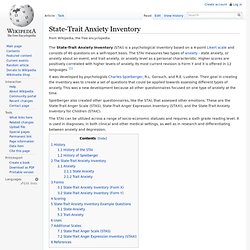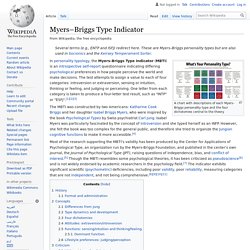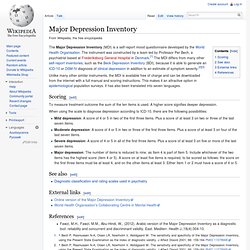

Self-report study. A self-report study is a type of survey, questionnaire, or poll in which respondents read the question and select a response by themselves without researcher interference.

A self-report is any method which involves asking a participant about their feelings, attitudes, beliefs and so on. Examples of self-reports are questionnaires and interviews; self-reports are often used as a way of gaining participants' responses in observational studies and experiments. Self-report studies have validity problems. Patients may exaggerate symptoms in order to make their situation seem worse, or they may under-report the severity or frequency of symptoms in order to minimize their problems. Patients might also simply be mistaken or misremember the material covered by the survey. State-Trait Anxiety Inventory. The State-Trait Anxiety Inventory (STAI) is a psychological inventory based on a 4-point Likert scale and consists of 40 questions on a self-report basis.

The STAI measures two types of anxiety - state anxiety, or anxiety about an event, and trait anxiety, or anxiety level as a personal characteristic. Higher scores are positively correlated with higher levels of anxiety. Its most current revision is Form Y and it is offered in 12 languages. [1] It was developed by psychologists Charles Spielberger, R.L. Gorsuch, and R.E. Spielberger also created other questionnaires, like the STAI, that assessed other emotions. Revised NEO Personality Inventory. Myers-Briggs Type Indicator. Model of personality types A chart with descriptions of each Myers–Briggs personality type and the four dichotomies central to the theory The Myers–Briggs Type Indicator (MBTI) is an introspective self-report questionnaire indicating differing psychological preferences in how people perceive the world and make decisions.[1][2][3] The original versions of the MBTI were constructed by two Americans, Katharine Cook Briggs and her daughter Isabel Briggs Myers.[4] The MBTI is based on the conceptual theory proposed by Swiss psychiatrist Carl Jung,[5] who had speculated that people experience the world using four principal psychological functions – sensation, intuition, feeling, and thinking – and that one of these four functions is dominant for a person most of the time.[6] The four categories are Introversion/Extraversion, Sensing/Intuition, Thinking/Feeling, Judging/Perception.

Each person is said to have one preferred quality from each category, producing 16 unique types. History[edit] Minnesota Multiphasic Personality Inventory. The Minnesota Multiphasic Personality Inventory (MMPI) is the most widely used and researched standardized psychometric test of adult personality and psychopathology.[1] Psychologists and other mental health professionals use various versions of the MMPI to develop treatment plans; assist with differential diagnosis; help answer legal questions (forensic psychology); screen job candidates during the personnel selection process; or as part of a therapeutic assessment procedure.[2] The original MMPI, first published by the University of Minnesota Press in 1943, was replaced by an updated version, the MMPI-2, in 1989.

A version for adolescents, the MMPI-A, was published in 1992. Major Depression Inventory. The Major Depression Inventory (MDI) is a self-report mood questionnaire developed by the World Health Organisation.

The instrument was constructed by a team led by Professor Per Bech, a psychiatrist based at Frederiksborg General Hospital in Denmark.[1] The MDI differs from many other self-report inventories, such as the Beck Depression Inventory (BDI), because it is able to generate an ICD-10 or DSM-IV diagnosis of clinical depression in addition to an estimate of symptom severity.[2][3] Unlike many other similar instruments, the MDI is available free of charge and can be downloaded from the internet with a full manual and scoring instructions.
This makes it an attractive option in epidemiological population surveys. It has also been translated into seven languages. Geriatric Depression Scale. The Geriatric Depression Scale (GDS) is a 30-item self-report assessment used to identify depression in the elderly.

The scale was first developed in 1982 by J.A. Yesavage and others.[1] Description[edit] The GDS questions are answered "yes" or "no", instead of a five-category response set. This simplicity enables the scale to be used with ill or moderately cognitively impaired individuals. Scale questions and scoring[edit] Are you basically satisfied with your life? Original scoring for the scale: one point for each of these answers. See also[edit] Diagnostic classification and rating scales used in psychiatry. Eysenck Personality Questionnaire. In psychology, Eysenck Personality Questionnaire (EPQ) is a questionnaire to assess the personality traits of a person.

It was devised by the psychologists Hans Jürgen Eysenck and his wife Sybil B. G. California Psychological Inventory. Beck Hopelessness Scale. The Beck Hopelessness Scale (BHS) is a 20-item self-report inventory developed by Dr.

Aaron T. Beck that was designed to measure three major aspects of hopelessness: feelings about the future, loss of motivation, and expectations.[1] The test is designed for adults, age 17-80. It measures the extent of the respondent's negative attitudes, or pessimism, about the future. It may be used as an indicator of suicidal risk in depressed people who have made suicide attempts.
Beck Depression Inventory. The Beck Depression Inventory (BDI, BDI-1A, BDI-II), created by Dr.

Aaron T. Beck, is a 21-question multiple-choice self-report inventory, one of the most widely used instruments for measuring the severity of depression. Its development marked a shift among health care professionals, who had until then viewed depression from a psychodynamic perspective, instead of it being rooted in the patient's own thoughts. In its current version the questionnaire is designed for individuals aged 13 and over, and is composed of items relating to symptoms of depression such as hopelessness and irritability, cognitions such as guilt or feelings of being punished, as well as physical symptoms such as fatigue, weight loss, and lack of interest in sex.[1]
Beck Anxiety Inventory. The Beck Anxiety Inventory (BAI), created by Dr.

Aaron T. Beck and other colleagues, is a 21-question multiple-choice self-report inventory that is used for measuring the severity of an individual's anxiety. BAI[edit] The BAI consists of twenty-one questions about how the subject has been feeling in the last week, expressed as common symptoms of anxiety (such as numbness and tingling, sweating not due to heat, and fear of the worst happening).
It is designed for an age range of 17–80 years old. NOT AT ALL (0 points)MILDLY: It did not bother me much. (1 point)MODERATELY: It was very unpleasant, but I could stand it. (2 points)SEVERELY: I could barely stand it. (3 points) 16PF Questionnaire. The Sixteen Personality Factor Questionnaire (or 16PF),[1] is a multiple-choice personality questionnaire which was developed over several decades of research by Raymond B.
Cattell, Maurice Tatsuoka and Herbert Eber. Beginning in the 1940s, Cattell used the new techniques of factor analysis (based on the correlation coefficient) in an attempt to try to discover and measure the source traits of human personality (Cattell, 1946)(Nevid, 2009).[2][3] The questionnaire measures the 16 primary traits, and the Big Five secondary traits,[4][5] which have become popularized by other authors in recent years. From early in his research, Cattell found that the structure of personality was multi-level and hierarchical, with a structure of interdependent primary and secondary level traits (Cattell, 1946, 1957).[2][6] The sixteen primary factors were a result of factor-analyzing hundreds of measures of everyday behaviors to find the fundamental traits behind them.